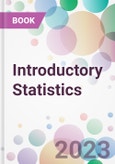The goal of the book is to provide sufficient understanding of how to organize and summarize datasets through descriptive and inferential statistics for good decision-making. A chapter on ethics also informs readers about best practices for using statistics in research and analysis.
Topics covered:
1. Introduction to Statistics
2. Summarizing and Graphing
3. Basic Concepts of Probability
4. Discrete Random Variables
5. Continuous Random Variables
6. Sampling Distributions
7. Estimation
8. Hypothesis Testing
9. Correlation and Regression
10. Ethics
Table of Contents
Chapter 1: Introduction- Data Types
- Sample Data
- Conclusion
- Introduction
- Frequency Distributions and Histograms
- Graphs
- Conclusion
- Introduction
- Samples Events and Their Probabilities
- Sample Spaces
- Event
- Examples
- Example 1
- Example 2
- Example 3
- Example 4
- Experiment
- Definition:
- Example 5
- Probability
- Examples
- Example 1
- Example 2
- Example 3
- Example 4
- Example 5
- Complements, Intersections, and Unions
- Complement
- Examples
- Example 1
- Probability Rule for Complements
- Example 2
- Intersection of Events
- Examples
- Example 1
- Example 2
- Probability Rule for Mutually Exclusive Events
- Example
- Union of Events
- Examples
- Example 1
- Example 2
- Additive Rule of Probability
- Example 3
- Example 4
- Example 5
- Conditional Probability and Independent Occurrences
- Conditional Probability
- Examples
- Example 1
- Example 2
- Example 3
- Independent Events
- Examples
- Example 1
- Example 2
- Example 3
- Example 4
- Probability in Tree Diagrams
- Example
- Principles
- Conclusion
- Introduction
- Random Variables
- Understanding Random Variables
- Types of Random Variables
- Example of Random Variable
- Example:
- Examples of Probability Distributions for Discrete Random Variables (Drv)
- Example 1
- Example 2
- Examples
- Example # 1
- Example # 2
- Example # 3
- Variance of Discrete Random Variables
- Characteristics and Notations
- Binominal Distribution
- Understanding Binominal Distribution
- Analyzing Binominal Distribution
- Criteria for Binominal Distribution
- Examples of Binominal Distributions
- Trial 1
- Trial 2
- Trial 3
- Cumulative Binominal Probability
- Negative Binominal Distribution
- Notations
- The Mean of Negative Binominal Distribution
- Conclusion
- Introduction
- Probability Distribution of Continuous Random Variable
- Properties
- Probability Density Functions
- Cumulative Distribution Functions
- Examples of Probability Distribution of Continuous Random Variable
- Example # 1
- The Normal Distribution
- Understanding Normal Distribution
- Kurtosis and Skewness
- Central Limit Theorem
- Sample Mean
- Convergence to Normal Distribution
- The Standard Normal Distribution
- The Standard Normal Distribution Vs
- Standardizing Normal Distribution
- How to Calculate Z-Score
- Example of Finding Z -Score
- To Find Probability Using the Normal Standard Distribution
- P Values and Z-Tests
- How to Use Z-Table
- Example: Using Z Distribution to Find Probability
- Areas of Tails of Distribution
- Tails of Standard Normal Distribution
- Conclusion
- Introduction
- The Mean and Standard Deviation (Sd) of the Sample Mean
- Examples
- Example 1
- Example 2
- The Sampling Distribution of the Sample Mean
- The Central Limit Theorem
- Examples
- Example 1
- Example 2
- Solution [44]
- Example 3
- Example 4
- Normally Distributed Populations
- Standard Deviation of X¯ (Standard Error) [44]
- Z-Score of the Sample Mean [44]
- Examples
- Example 1
- Example 2
- Example 3
- The Sample Proportion
- Sample Proportions in a Small Population:
- The Sampling Distribution of the Sample Proportion
- Examples
- Example 1
- Example 2
- Example 3
- Conclusion
- Introduction
- Construction of Confidence Intervals
- Interval Estimate Vs
- Intervals of Confidence
- Confidence Level
- The Error Margin
- Estimator
- Interval Vs
- Types of Estimators
- What is Standard Error (Sde)?
- Standard Deviation (Sd) of Sample Estimates
- Standard Error (Se) of Sample Estimates
- Margin of Error
- How to Calculate the Error Margin
- What is the Critical Value and How Do I Find It?
- What is a Confidence Interval, and How Does It Work?
- Confidence Intervals and How to Interpret Them
- Data Requirements for Confidence Interval
- What is a Confidence Interval, and How Do I Make One?
- Bias and Error
- Mse Stands for Mean Squared Error
- Sample Size and Estimates
- Determining the Sample Size is Necessary to Estimate the Population Mean
- Examples
- Example
- Large Sample Estimation of a Population Mean
- Large Sample 100 (1 - Α) % Confidence Interval for a Population Mean
- Example
- Small Sample Estimation of a Population Mean
- Small Sample 100 (1 -Α) % Confidence Interval for a Population Mean [53]
- Example 1
- Example 2
- Determining Sample Size Required to Estimate Population Proportion (P)
- Example
- Estimating the Target Parameter: Point Estimation
- Maximum Likelihood
- Linear Least Squares (Lls)
- Estimating the Target Parameter: Interval Estimation
- Example
- The T Distribution
- Estimating a Population Proportion
- Using Confidence Intervals to Determine the Population Proportion
- Examples
Author
- Alandra Kahl







